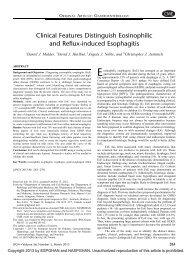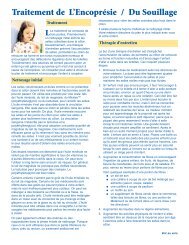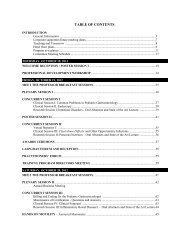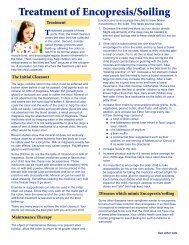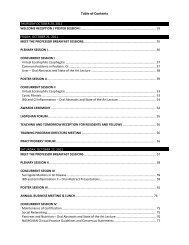Use of the Noninvasive Entero-test in the ... - NASPGHAN.org
Use of the Noninvasive Entero-test in the ... - NASPGHAN.org
Use of the Noninvasive Entero-test in the ... - NASPGHAN.org
You also want an ePaper? Increase the reach of your titles
YUMPU automatically turns print PDFs into web optimized ePapers that Google loves.
ORIGINAL ARTICLE: GASTROENTEROLOGY<br />
<strong>Use</strong> <strong>of</strong> <strong>the</strong> <strong>Non<strong>in</strong>vasive</strong> <strong>Entero</strong>-<strong>test</strong> <strong>in</strong> <strong>the</strong> Detection <strong>of</strong><br />
Helicobacter pylori <strong>in</strong> Children <strong>in</strong> an Endemic<br />
Area <strong>in</strong> Colombia<br />
<br />
Richard N. Arboleda, Barbara G. Schneider, y Luis E. Bravo, Judith Romero-Gallo,<br />
<br />
Richard M. Peek Jr, Robert<strong>in</strong>o M. Mera, z Maria Clara Yepez,<br />
z Crist<strong>in</strong>a Campo, and Pelayo Correa<br />
ABSTRACT<br />
Background and Objective: Gastric <strong>in</strong>fection with Helicobacter pylori<br />
(H pylori), a strong risk factor for gastric cancer, is highly prevalent <strong>in</strong><br />
children resid<strong>in</strong>g <strong>in</strong> <strong>the</strong> Colombian Andes. We aimed to validate <strong>the</strong> use <strong>of</strong><br />
<strong>the</strong> <strong>Entero</strong>-<strong>test</strong> to culture and genotype H pylori stra<strong>in</strong>s from asymptomatic<br />
Colombian children.<br />
Methods: Children (ages 10–15 years, n ¼ 110, 80 <strong>of</strong> which were H pylori<br />
positive by <strong>the</strong> urea breath <strong>test</strong> [UBT]) were subjected to <strong>the</strong> <strong>Entero</strong>-<strong>test</strong>, and<br />
str<strong>in</strong>gs were cultured and/or used for DNA extraction for polymerase cha<strong>in</strong><br />
reaction (PCR). These children had been treated for H pylori <strong>in</strong> 2007. A<br />
second population <strong>of</strong> children (ages 10–15 years, n ¼ 95),which had not<br />
been previously treated, was also subjected to <strong>the</strong> <strong>Entero</strong>-<strong>test</strong>.<br />
Results: Of UBT-positive children <strong>in</strong> <strong>the</strong> treated group, 29 <strong>of</strong> 80 (36%)<br />
<strong>Entero</strong>-<strong>test</strong> samples were H pylori culture positive; 29 additional str<strong>in</strong>g<br />
extracts were <strong>test</strong>ed by PCR for <strong>the</strong> H pylori virulence factors cagA and<br />
vacA. PCR from cultures and extracts yielded a sensitivity <strong>of</strong> 74% and<br />
specificity <strong>of</strong> 87%. In <strong>the</strong> untreated group, 16 <strong>of</strong> 94 UBT-positive children<br />
(17%) produced <strong>Entero</strong>-<strong>test</strong>s that were culture positive. Fifty-eight <strong>of</strong><br />
94 (62%) str<strong>in</strong>g extracts were PCR positive for cagA and/or vacA. In<br />
previously treated children, H pylori stra<strong>in</strong>s were more <strong>of</strong>ten <strong>the</strong> less<br />
virulent vacA s2 (P ¼ 0.001), m2 (P ¼ 0.006), and i2 genotypes (P ¼ 0.039).<br />
Conclusions: The <strong>Entero</strong>-<strong>test</strong> may be used as a non<strong>in</strong>vasive <strong>test</strong> to detect<br />
H pylori <strong>in</strong> asymptomatic children resid<strong>in</strong>g <strong>in</strong> high-risk areas for gastric<br />
cancer. Treatment <strong>of</strong> H pylori <strong>in</strong> children was associated with less virulent<br />
genotypes.<br />
Key Words: cagA, gastric <strong>in</strong>fection, str<strong>in</strong>g <strong>test</strong>, vacA, virulence<br />
(JPGN 2013;57: 192–196)<br />
Received July 13, 2012; accepted March 22, 2013.<br />
From <strong>the</strong> Department <strong>of</strong> Medic<strong>in</strong>e, Division <strong>of</strong> Gastroenterology,<br />
Vanderbilt University School <strong>of</strong> Medic<strong>in</strong>e, Nashville, TN, <strong>the</strong><br />
yDepartment <strong>of</strong> Pathology, Universidad del Valle School <strong>of</strong> Medic<strong>in</strong>e,<br />
Cali, and <strong>the</strong> zUniversidad de Nariño, Pasto, Colombia.<br />
Address correspondence and repr<strong>in</strong>t requests to Barbara G. Schneider, PhD,<br />
Department <strong>of</strong> Medic<strong>in</strong>e, Vanderbilt University Medical Center, 2215<br />
Garland Ave, Room 1030C MRB4, Nashville, TN 37232 (e-mail:<br />
barbara.schneider@vanderbilt.edu).<br />
This article has been developed as a Journal CME Activity by NASP-<br />
GHAN. Visit http://www.naspghan.<strong>org</strong>/wmspage.cfm?parm1=742 to<br />
view <strong>in</strong>structions, documentation, and <strong>the</strong> complete necessary steps<br />
to receive CME credit for read<strong>in</strong>g this article.<br />
The authors report no conflicts <strong>of</strong> <strong>in</strong>terest.<br />
Copyright # 2013 by European Society for Pediatric Gastroenterology,<br />
Hepatology, and Nutrition and North American Society for Pediatric<br />
Gastroenterology, Hepatology, and Nutrition<br />
DOI: 10.1097/MPG.0b013e318293e1e1<br />
Gastric cancer is <strong>the</strong> fourth most commonly diagnosed cancer<br />
and second lead<strong>in</strong>g cause <strong>of</strong> cancer deaths worldwide,<br />
responsible for 738,000 deaths <strong>in</strong> 2008 (1). In many parts <strong>of</strong> <strong>the</strong><br />
world, such as <strong>the</strong> Andean regions <strong>of</strong> Lat<strong>in</strong> America, this disease is<br />
<strong>the</strong> most common cause <strong>of</strong> cancer-related death. Identification <strong>of</strong><br />
Helicobacter pylori (H pylori) as a risk factor for gastric cancer (2)<br />
has revealed a new set <strong>of</strong> challenges for reduc<strong>in</strong>g <strong>the</strong> mortality <strong>of</strong><br />
<strong>the</strong> disease. As part <strong>of</strong> ongo<strong>in</strong>g studies <strong>in</strong> <strong>the</strong> natural history <strong>of</strong><br />
<strong>in</strong>fection, a cohort <strong>of</strong> children was previously established <strong>in</strong> <strong>the</strong><br />
Andean region <strong>of</strong> Colombia, where H pylori has a high prevalence<br />
<strong>in</strong> untreated children (3), and <strong>the</strong> proportion <strong>of</strong> <strong>in</strong>fected children<br />
<strong>in</strong>creased with age (53% for 2-year-olds and 87% for 9-year-old<br />
asymptomatic children (4)). Large-scale <strong>in</strong>vestigations <strong>of</strong> H pylori<br />
<strong>in</strong> asymptomatic children <strong>in</strong> endemic areas have been limited<br />
because <strong>of</strong> <strong>the</strong> <strong>in</strong>ability to obta<strong>in</strong> biopsies for ethical reasons.<br />
The <strong>Entero</strong>-<strong>test</strong> has been validated as a non<strong>in</strong>vasive procedure to<br />
obta<strong>in</strong> H pylori from gastric samples, with a variable diagnostic<br />
efficacy <strong>of</strong> culture and/or polymerase cha<strong>in</strong> reaction (PCR) rang<strong>in</strong>g<br />
from 37% to 97% (5,6); however, <strong>the</strong>se studies have been performed<br />
<strong>in</strong> adults, and none have <strong>in</strong>cluded children <strong>in</strong> an endemic<br />
area.<br />
Previous studies have shown a difference <strong>in</strong> <strong>the</strong> virulence<br />
<strong>of</strong> stra<strong>in</strong>s <strong>in</strong> children depend<strong>in</strong>g on age and history <strong>of</strong> treatment.<br />
For example, some reports <strong>in</strong>dicate that genotypes<br />
recovered from children are less virulent than those <strong>of</strong> adults<br />
(7). The virulence-associated genes cagA and vacA play a role <strong>in</strong><br />
<strong>the</strong> pathogenesis <strong>of</strong> Hpylori.ThecagA gene, which encodes a<br />
120- to 145-kDa prote<strong>in</strong>, is a marker for <strong>the</strong> cag pathogenicity<br />
island and is found <strong>in</strong> >50% <strong>of</strong> Hpyloristra<strong>in</strong>s (8). The cagA<br />
gene, closely associated with <strong>the</strong> vacA s1 genotype, is considered<br />
an <strong>in</strong>ducer <strong>of</strong> pro<strong>in</strong>flammatory cytok<strong>in</strong>es <strong>in</strong> <strong>the</strong> gastric mucosa<br />
and is a risk factor for disease (9,10). The vacA gene encodes an<br />
88-kDa vacuolat<strong>in</strong>g cytotox<strong>in</strong> (VacA) that forms pores <strong>in</strong> eukaryotic<br />
cell membranes (11). With<strong>in</strong> <strong>the</strong> vacA gene, 3 regions <strong>of</strong><br />
marked sequence diversity can be dist<strong>in</strong>guished: <strong>the</strong> s region<br />
(encod<strong>in</strong>g <strong>the</strong> signal peptide) is present as ei<strong>the</strong>r an s1 or an s2<br />
allele, <strong>the</strong> <strong>in</strong>termediate region is present as ei<strong>the</strong>r i1 or i2, and <strong>the</strong><br />
m region (<strong>the</strong> middle region <strong>of</strong> <strong>the</strong> tox<strong>in</strong>) can be ei<strong>the</strong>r m1 or m2<br />
(12–14). The mosaic comb<strong>in</strong>ation <strong>of</strong> s and m region alleles<br />
determ<strong>in</strong>es <strong>the</strong> production <strong>of</strong> <strong>the</strong> vacuolat<strong>in</strong>g cytotox<strong>in</strong> and is<br />
associated with <strong>the</strong> pathogenicity <strong>of</strong> <strong>the</strong> bacterium. VacA s1m1<br />
stra<strong>in</strong>shavebeenassociatedwith<strong>in</strong>creased virulence and greater<br />
gastric epi<strong>the</strong>lial damage and ulceration than s2m2 stra<strong>in</strong>s<br />
(12,15). Our aim was to validate <strong>the</strong> use <strong>of</strong> <strong>the</strong> <strong>Entero</strong>-<strong>test</strong> as<br />
a non<strong>in</strong>vasive <strong>test</strong> to identify <strong>the</strong> presence <strong>of</strong> H pylori and<br />
evaluate <strong>the</strong> prevalence <strong>of</strong> Hpylori–specific virulence genotypes<br />
<strong>in</strong> an endemic area.<br />
192 JPGN Volume 57, Number 2, August 2013<br />
Copyright 2013 by ESPGHAN and <strong>NASPGHAN</strong>. Unauthorized reproduction <strong>of</strong> this article is prohibited.
JPGN Volume 57, Number 2, August 2013<br />
<strong>Entero</strong>-<strong>test</strong> for <strong>the</strong> Detection <strong>of</strong> Helicobacter pylori <strong>in</strong> Children<br />
METHODS<br />
Subjects<br />
All subjects’ parents provided <strong>in</strong>formed consent for<br />
participation <strong>in</strong> accordance with <strong>the</strong> standard <strong>of</strong> <strong>the</strong> ethics review<br />
boards that approved this study: The Vanderbilt University <strong>in</strong>stitutional<br />
review board and <strong>the</strong> research ethics committee <strong>of</strong> <strong>the</strong><br />
Universidad <strong>of</strong> Nariño. Two rural communities <strong>of</strong> children liv<strong>in</strong>g<br />
<strong>in</strong> close proximity to each o<strong>the</strong>r with similar demographics <strong>in</strong> <strong>the</strong><br />
endemic region <strong>of</strong> Nariño, Colombia, were selected. As part <strong>of</strong> an<br />
earlier study evaluat<strong>in</strong>g <strong>the</strong> effect <strong>of</strong> H pylori <strong>in</strong>fection on growth<br />
velocity, a cohort <strong>of</strong> asymptomatic children was established <strong>in</strong> both<br />
communities <strong>in</strong> which 1 group <strong>of</strong> children (from towns <strong>of</strong> Nariño<br />
and Genoy) received a course <strong>of</strong> anti-H pylori treatment <strong>in</strong> 2007with<br />
poor results and <strong>the</strong> o<strong>the</strong>r (from towns <strong>of</strong> Laguna and Cabrera) was<br />
observed without treatment (3). The 2 regions have predom<strong>in</strong>antly<br />
rural populations <strong>of</strong> similar ancestry and socioeconomic status.<br />
Both groups cont<strong>in</strong>ue to be monitored by urea breath <strong>test</strong> (UBT).<br />
With<strong>in</strong> 4 to 8 weeks <strong>of</strong> a UBT (delta over basel<strong>in</strong>e >5 parts per<br />
thousand was considered a positive <strong>test</strong>), subjects were <strong>of</strong>fered <strong>the</strong><br />
opportunity to participate <strong>in</strong> evaluation us<strong>in</strong>g <strong>the</strong> <strong>Entero</strong>-<strong>test</strong>.<br />
Children were recruited from both communities <strong>in</strong>dependent <strong>of</strong><br />
UBT status. From <strong>the</strong> treated population, 110 children participated<br />
(80 UBT positive and 30 UBT negative); from <strong>the</strong> untreated<br />
population, 95 participated (94 UBT positive and 1 UBT negative).<br />
Str<strong>in</strong>g Samples (<strong>Entero</strong>-<strong>test</strong>)<br />
The pediatric <strong>Entero</strong>-<strong>test</strong> consists <strong>of</strong> a small plastic capsule<br />
attached to a 90-cm str<strong>in</strong>g made <strong>of</strong> absorbent material. The capsule is<br />
swallowed with water and dissolves <strong>in</strong> <strong>the</strong> stomach lumen, leav<strong>in</strong>g a<br />
str<strong>in</strong>g that collects gastric juices that may harbor H pylori. Before<br />
<strong>test</strong><strong>in</strong>g, to adjust <strong>the</strong> device for <strong>the</strong> <strong>in</strong>dividual, length measurements<br />
from <strong>the</strong> nose to laryngeal prom<strong>in</strong>ence to xyphoid process <strong>of</strong> each<br />
subject were recorded. Recorded measurements were subtracted from<br />
<strong>the</strong> total length <strong>of</strong> <strong>the</strong> <strong>Entero</strong>-<strong>test</strong> (90 cm) and <strong>the</strong> difference was<br />
excluded from <strong>the</strong> amount <strong>of</strong> str<strong>in</strong>g that could be swallowed, to reduce<br />
<strong>the</strong> risk <strong>of</strong> hav<strong>in</strong>g <strong>the</strong> str<strong>in</strong>g enter <strong>the</strong> duodenum. Collection <strong>of</strong><br />
samples <strong>in</strong> both populations was done by <strong>the</strong> same group <strong>of</strong> tra<strong>in</strong>ed<br />
nurses who followed a uniform protocol for collection <strong>of</strong> samples,<br />
with <strong>the</strong> exception <strong>of</strong> <strong>the</strong> time <strong>the</strong> str<strong>in</strong>gs were left <strong>in</strong> <strong>the</strong> stomach,<br />
which was 30 m<strong>in</strong>utes <strong>in</strong> <strong>the</strong> treated group. This <strong>in</strong>itial time period<br />
was based on <strong>the</strong> study <strong>in</strong> adults by Yoshida et al (16), who reported<br />
comparable sensitivity with studies us<strong>in</strong>g longer <strong>in</strong>cubation times<br />
(1 hour) (17–20). Follow<strong>in</strong>g our evaluation <strong>of</strong> results from this<br />
protocol, and <strong>in</strong> an attempt to <strong>in</strong>crease <strong>the</strong> percentage <strong>of</strong> successful<br />
cultures, we used an <strong>in</strong>cubation time <strong>of</strong> 45 m<strong>in</strong>utes <strong>in</strong> <strong>the</strong> untreated<br />
group. After remov<strong>in</strong>g <strong>the</strong> str<strong>in</strong>gs, pH <strong>of</strong> fluid from <strong>the</strong> str<strong>in</strong>g was<br />
checked us<strong>in</strong>g pH paper strips. The distal portion (approximately<br />
5 cm) <strong>of</strong> each str<strong>in</strong>g was placed <strong>in</strong> transport media (thioglycolate þ<br />
20% glycerol) under sterile conditions, frozen, and transferred <strong>in</strong> dry<br />
ice to Vanderbilt University for culture and PCR (17,21). Frozen<br />
samples were thawed, plated on antibiotic plates (trypticase soy agar<br />
þ 5% sheep blood, vancomyc<strong>in</strong> 20 mg/mL, nalidixic acid 10 mg/mL,<br />
bacitrac<strong>in</strong> 30 mg/ml, amphoteric<strong>in</strong> 2 mg/mL), and placed <strong>in</strong> microaerobic<br />
conditions, us<strong>in</strong>g Campy Pak Plus envelopes (Difco/BBL,<br />
Lawrence, KS) at 378C for 5 to 7 days. H pylori colonies were<br />
identified on <strong>the</strong> basis <strong>of</strong> morphology and positive <strong>test</strong>s for urease,<br />
oxidase, and gram sta<strong>in</strong>. S<strong>in</strong>gle colonies were <strong>the</strong>n frozen until<br />
removed for DNA extraction.<br />
Preparation <strong>of</strong> Genomic DNA from <strong>Entero</strong>-<strong>test</strong><br />
Samples<br />
DNA was extracted from s<strong>in</strong>gle colony cultures <strong>of</strong> H pylori<br />
us<strong>in</strong>g prote<strong>in</strong>ase K (1 mg/mL <strong>in</strong> 50 mmol/L Tris/HCl buffer, pH 8.0,<br />
with 1 mmol/L ethylene diam<strong>in</strong>e tetraacetate and 0.45% Tween 20)<br />
at 528C overnight, followed by heat<strong>in</strong>g at 958C for 15 m<strong>in</strong>utes to<br />
denature <strong>the</strong> prote<strong>in</strong>ase K. DNA was extracted with phenol/chlor<strong>of</strong>orm<br />
and precipitated with ethanol. DNA pellets were washed with<br />
70% ethanol and resuspended <strong>in</strong> Tris-ethylene diam<strong>in</strong>e tetraacetate<br />
buffer. For those subjects from whose <strong>Entero</strong>-<strong>test</strong>s no s<strong>in</strong>gle colony<br />
cultures could be obta<strong>in</strong>ed, duplicate str<strong>in</strong>g segments were digested<br />
<strong>in</strong> 150 mL <strong>of</strong> prote<strong>in</strong>ase K at 528C overnight. Digested material was<br />
heated at 958C for 15 m<strong>in</strong>utes to denature <strong>the</strong> prote<strong>in</strong>ase K, and <strong>the</strong><br />
supernatant from this preparation was used as a template for PCR<br />
(22).<br />
PCR Amplification and Genotyp<strong>in</strong>g <strong>of</strong> Isolated<br />
Stra<strong>in</strong>s<br />
To reduce <strong>the</strong> risk <strong>of</strong> reaction contam<strong>in</strong>ation, PCR assembly<br />
was performed <strong>in</strong> a dedicated area, filtered pipette tips were used,<br />
and all handl<strong>in</strong>g <strong>of</strong> PCR products was performed <strong>in</strong> a different<br />
laboratory. Str<strong>in</strong>g extracts and DNA isolated from s<strong>in</strong>gle colonies<br />
underwent PCR for virulence factors (cagA and vacA s, m, and i<br />
regions). The cagA gene was detected with primers (CagAF,<br />
CagAR) yield<strong>in</strong>g amplimers <strong>of</strong> 183 bp (23). To amplify vacA s<br />
regions, primers VA1F and VA1R were selected, result<strong>in</strong>g <strong>in</strong><br />
generation <strong>of</strong> fragments <strong>of</strong> 259 bp for type s1 variants or fragments<br />
<strong>of</strong> 286 bp for type s2 variants (12). For <strong>the</strong> detection <strong>of</strong> <strong>the</strong> m region<br />
<strong>of</strong> <strong>the</strong> vacA gene, a mixture <strong>of</strong> 2 forward primers (M2F1, M1F2) and<br />
2 reverse primers (M2R1, M1R2) was used <strong>in</strong> a simplex PCR,<br />
result<strong>in</strong>g <strong>in</strong> amplification <strong>of</strong> fragments <strong>of</strong> 300 bp for m1 or 200 bp<br />
for m2 stra<strong>in</strong>s (24). For <strong>the</strong> i1 region <strong>of</strong> <strong>the</strong> vacA gene, primers<br />
V335F and C1R were used; V335 and C2R were used for <strong>the</strong> i2<br />
region result<strong>in</strong>g <strong>in</strong> amplification <strong>of</strong> fragments <strong>of</strong> 426 bp and 432 bp,<br />
respectively (11).<br />
H pylori stra<strong>in</strong> PZ5081 (genotype cagAþ, vacA s1/m1) was<br />
used as a control for <strong>the</strong> presence <strong>of</strong> <strong>the</strong> cagA gene. Stra<strong>in</strong>s PZ5106<br />
(genotype cagAþ, vacA s1/m2/i1) and PZ5081 were used as controls<br />
for vacA genotypes. These positive controls for cagA and vacA<br />
genotypes had been validated by Sanger sequenc<strong>in</strong>g. Additionally,<br />
no-template controls were used <strong>in</strong> each experiment.<br />
All PCR mixtures consisted <strong>of</strong> 0.2 mmol/L <strong>of</strong> each dNTP,<br />
0.2 mmol <strong>of</strong> each forward and reverse primer, 1.0 U <strong>of</strong> Amplitaq<br />
Gold DNA polymerase (Invitrogen, Carlsbad, CA) <strong>in</strong> a f<strong>in</strong>al volume<br />
<strong>of</strong> 40 mL. Five microliters <strong>of</strong> DNA (20–50 ng) extracted from<br />
H pylori cultures was added to each reaction mixture. The PCR<br />
programs for cagA and vacAi amplification consisted <strong>of</strong> 15 m<strong>in</strong>utes<br />
at 958C, followed by 40 cycles <strong>of</strong> 1 m<strong>in</strong>ute at 948C, 1 m<strong>in</strong>ute at<br />
558C, 1 m<strong>in</strong>ute at 728C, and a f<strong>in</strong>al <strong>in</strong>cubation at 728C for 3 m<strong>in</strong>utes.<br />
The amplification programs for cagA and vacA i were as follows:<br />
15 m<strong>in</strong>utes at 95 o C, <strong>the</strong>n 40 cycles consist<strong>in</strong>g <strong>of</strong> 1 m<strong>in</strong>ute at 94 o C,<br />
1 m<strong>in</strong>ute anneal<strong>in</strong>g at 55 o C, and 1 m<strong>in</strong>ute at 72 o C, followed by a<br />
f<strong>in</strong>al <strong>in</strong>cubation for 3 m<strong>in</strong>utes at 72 o C. The amplification program<br />
for vacA s was identical except that 45 cycles were used <strong>in</strong>stead <strong>of</strong><br />
40, <strong>the</strong> anneal<strong>in</strong>g temperature was 52 o C, and <strong>the</strong> f<strong>in</strong>al extension was<br />
5 m<strong>in</strong>utes at 72 o C. For vacA m, 40 cycles were used, and <strong>the</strong><br />
anneal<strong>in</strong>g temperature was 58 o C. PCR products (10 mL <strong>of</strong> each<br />
sample) were electrophoresed <strong>in</strong> 2% agarose gels sta<strong>in</strong>ed with<br />
ethidium bromide for 1 hour at 100 V.<br />
Statistical Analysis<br />
Sensitivity, specificity, and <strong>the</strong>ir 95% confidence <strong>in</strong>tervals<br />
(CIs) for PCR us<strong>in</strong>g <strong>Entero</strong>-<strong>test</strong> culture or str<strong>in</strong>g extracts versus<br />
UBT were calculated with standard epidemiologic methods. A x 2<br />
<strong>test</strong> was used to study associations between categorical variables<br />
such as genotypes (cagAþ, vacA s1/s2, m1/m2, i1/i2), demographic<br />
www.jpgn.<strong>org</strong> 193<br />
Copyright 2013 by ESPGHAN and <strong>NASPGHAN</strong>. Unauthorized reproduction <strong>of</strong> this article is prohibited.
Arboleda et al JPGN Volume 57, Number 2, August 2013<br />
parameters (sex), and outcomes <strong>of</strong> attempts at culture. A t <strong>test</strong> was<br />
used to compare age distributions between <strong>the</strong> 2 populations. The<br />
Fisher exact <strong>test</strong> was used for compar<strong>in</strong>g numbers <strong>of</strong> mixed <strong>in</strong>fections<br />
<strong>in</strong> <strong>the</strong> 2 populations. We considered P 0.05 statistically<br />
significant. Calculations were performed us<strong>in</strong>g STATA statistical<br />
s<strong>of</strong>tware version 12 (StataCorp, College Station, TX).<br />
RESULTS<br />
Patient Characteristics<br />
In <strong>the</strong> treated group, <strong>the</strong> sex proportions were 55.5% male<br />
and 44.5% female; <strong>in</strong> <strong>the</strong> untreated group, <strong>the</strong> proportions were<br />
49.5% male and 50.5% female. The average age was 12.50 years<br />
(95% CI 12.27–12.74) <strong>in</strong> <strong>the</strong> treated group and 12.21 years (95% CI<br />
11.96–12.46) <strong>in</strong> <strong>the</strong> untreated group. Sex and age distributions<br />
between <strong>the</strong> treated and untreated groups were not significantly<br />
different. Prevalence <strong>of</strong> H pylori <strong>in</strong>fection, as measured by UBT,<br />
was 73% (95% CI 63%–81%) <strong>in</strong> <strong>the</strong> treated group and 99% (95%<br />
CI 93%–100%) <strong>in</strong> <strong>the</strong> untreated group.<br />
<strong>Entero</strong>-<strong>test</strong> Culture Yield<br />
Treated Population<br />
Culture yield for <strong>the</strong> <strong>Entero</strong>-<strong>test</strong> from UBT-positive subjects<br />
was 36% (29/80). Extracts <strong>of</strong> <strong>Entero</strong>-<strong>test</strong> str<strong>in</strong>gs fail<strong>in</strong>g to produce<br />
cultures underwent PCR for virulence factors (cagA, vacA), with<br />
detection <strong>of</strong> ei<strong>the</strong>r <strong>the</strong> cagA or vacA genes from str<strong>in</strong>g samples<br />
considered a positive result. Yield <strong>of</strong> PCR for UBT-positive but<br />
culture-negative samples was 59% (30/51). Analysis <strong>of</strong> comb<strong>in</strong>ed<br />
culture and str<strong>in</strong>g extracts provided an <strong>Entero</strong>-<strong>test</strong> yield <strong>of</strong> 74% (59/<br />
80). Of <strong>test</strong>s from 30 UBT-negative subjects, 3 never<strong>the</strong>less yielded<br />
cultures, and ano<strong>the</strong>r produced positive PCR results from its<br />
str<strong>in</strong>g extract.<br />
Untreated Population<br />
A total <strong>of</strong> 95 <strong>Entero</strong>-<strong>test</strong> str<strong>in</strong>gs were collected. Culture yield<br />
for <strong>the</strong> <strong>Entero</strong>-<strong>test</strong> us<strong>in</strong>g <strong>the</strong> longer <strong>in</strong>cubation time was 17% (16/94<br />
UBT-positive children). Yield <strong>of</strong> PCR from str<strong>in</strong>g extracts from<br />
<strong>Entero</strong>-<strong>test</strong>s that did not produce s<strong>in</strong>gle colony cultures was 74%<br />
(58/78 UBT-positive children). Analysis <strong>of</strong> comb<strong>in</strong>ed culture and<br />
str<strong>in</strong>g extracts provided an <strong>Entero</strong>-<strong>test</strong> yield <strong>of</strong> 79% (74/94 UBTpositive<br />
children).<br />
Culture yield was greater <strong>in</strong> <strong>the</strong> treated group (36%) when <strong>the</strong><br />
<strong>Entero</strong>-<strong>test</strong> was left <strong>in</strong> <strong>the</strong> stomach for 30 m<strong>in</strong>utes versus 45 m<strong>in</strong>utes<br />
<strong>in</strong> <strong>the</strong> untreated group (17%). The longer time period was associated<br />
with an <strong>in</strong>crease <strong>in</strong> contam<strong>in</strong>ation by o<strong>the</strong>r bacteria (P ¼ 0.0043);<br />
however, <strong>the</strong> H pylori detection rate among UBT-positive children<br />
was not significantly different <strong>in</strong> <strong>the</strong> 2 groups (79% <strong>in</strong> <strong>the</strong> untreated<br />
group with 17% cultures vs 74% <strong>in</strong> <strong>the</strong> treated group with 36%<br />
cultures, P ¼ 0.48)<br />
<strong>Entero</strong>-<strong>test</strong> Sensitivity and Specificity<br />
Treated Population<br />
In addition to <strong>the</strong> 80 <strong>Entero</strong>-<strong>test</strong> samples collected from<br />
UBT-positive children, 30 <strong>Entero</strong>-<strong>test</strong> samples were obta<strong>in</strong>ed from<br />
UBT-negative subjects. From those 30 samples, we cultured<br />
H pylori from 3 samples and amplified H pylori DNA (cagA) from<br />
an additional sample (Table 1). Us<strong>in</strong>g UBT as <strong>the</strong> criterion standard,<br />
<strong>the</strong> <strong>Entero</strong>-<strong>test</strong> had a sensitivity <strong>of</strong> 74% (95% CI 63–83), specificity<br />
<strong>of</strong> 87% (95% CI 69–96), positive predictive value (PPV) <strong>of</strong> 94%<br />
(95% CI 85–98), and negative predictive value (NPV) <strong>of</strong> 55% (95%<br />
CI 40–70); however, if <strong>the</strong> 3 samples from UBT-negative subjects<br />
that produced H pylori cultures are reclassified as true-positives, <strong>the</strong><br />
sensitivity, specificity, PPV, and NPV are 75% (95% CI 64–84),<br />
96% (95% CI 81–99), 98% (95% CI 92–100), and 55% (95% CI<br />
40–70). If culture <strong>of</strong> H pylori colonies alone (without analysis <strong>of</strong><br />
str<strong>in</strong>g extracts) is compared with <strong>the</strong> UBT results, we obta<strong>in</strong> a<br />
sensitivity <strong>of</strong> 37% (95% CI 26–48), specificity <strong>of</strong> 90% (95% CI<br />
73–98), PPV <strong>of</strong> 91% (95% CI 75–98), and NPV <strong>of</strong> 35% (95% CI<br />
24–46). All colonies produced genotyp<strong>in</strong>g results for at least<br />
1 amplicon.<br />
Untreated Population<br />
H pylori prevalence rates were naturally so high <strong>in</strong> <strong>the</strong>se<br />
communities that <strong>in</strong>sufficient numbers <strong>of</strong> UBT-negative children<br />
were available <strong>in</strong> <strong>the</strong> untreated community for calculat<strong>in</strong>g sensitivity,<br />
specificity, PPVs, and NPVs.<br />
Genotyp<strong>in</strong>g <strong>of</strong> H pylori Stra<strong>in</strong>s<br />
Primers for cagA and vacA amplified <strong>the</strong> expected fragments<br />
<strong>of</strong> 183 bp for cagA, 259 bp for vacA s1, and 286 bp for vacA s2.<br />
Primers for vacA m1/m2 and i1/i2 amplified <strong>the</strong> expected fragments<br />
<strong>of</strong> 300 bp/200 bp and 426 bp/432 bp, respectively.<br />
As shown <strong>in</strong> Table 2, <strong>in</strong> samples from UBT-positive<br />
children <strong>in</strong> both groups, most samples were cagA positive<br />
(78% <strong>in</strong> <strong>the</strong> treated group and 80% <strong>in</strong> <strong>the</strong> untreated group).<br />
To elim<strong>in</strong>ate stra<strong>in</strong>s that were false-negatives because <strong>of</strong> lack <strong>of</strong><br />
amplifiable DNA, we removed those from <strong>the</strong> group <strong>of</strong> cagAnegative<br />
stra<strong>in</strong>s that had failed to provide a detectable signal for<br />
any amplicon. The majority <strong>of</strong> <strong>the</strong> stra<strong>in</strong>s <strong>in</strong> both groups were<br />
vacA s1 and/or m1, but <strong>the</strong> previously treated group had a<br />
significantly lower proportion <strong>of</strong> virulent s1 (P ¼ 0.001), m1<br />
(P ¼ 0.006), and i1 (P ¼ 0.039) stra<strong>in</strong>s compared with <strong>the</strong><br />
untreated group. To exam<strong>in</strong>e <strong>the</strong> evidence for mixed <strong>in</strong>fections,<br />
we evaluated PCR results from str<strong>in</strong>g extracts, us<strong>in</strong>g vacA s, m,<br />
and i assays, and counted <strong>the</strong> presence <strong>of</strong> any <strong>of</strong> <strong>the</strong> follow<strong>in</strong>g:<br />
both s1 and s2, m1 and m2, or i1 and i2 for any extract, as a<br />
positive <strong>in</strong>dicator for mixed <strong>in</strong>fection. We found 14% (8/59) for<br />
<strong>the</strong> treated group and 1% (1/74) for <strong>the</strong> untreated group<br />
(P ¼ 0.01).<br />
TABLE 1. Diagnostic efficacy <strong>of</strong> <strong>the</strong> <strong>Entero</strong>-<strong>test</strong><br />
Treated group <strong>Entero</strong>-<strong>test</strong> results<br />
Urea breath <strong>test</strong><br />
Positive Negative Total<br />
Sensitivity, %<br />
(95% CI)<br />
Specificity, %<br />
(95% CI)<br />
PPV, %<br />
(95% CI)<br />
NPV, %<br />
(95% CI)<br />
Culture/extract positive 59 4 63 74 (63–83) 87 (69–96) 94 (85–98) 55 (40–70)<br />
Culture/extract negative 21 26 47<br />
Total 80 30 110<br />
CI ¼ Confidence <strong>in</strong>terval; NPV ¼ negative predictive value; PPV ¼ positive predictive value.<br />
194 www.jpgn.<strong>org</strong><br />
Copyright 2013 by ESPGHAN and <strong>NASPGHAN</strong>. Unauthorized reproduction <strong>of</strong> this article is prohibited.
JPGN Volume 57, Number 2, August 2013<br />
<strong>Entero</strong>-<strong>test</strong> for <strong>the</strong> Detection <strong>of</strong> Helicobacter pylori <strong>in</strong> Children<br />
TABLE 2. Genotypes <strong>of</strong> H pylori stra<strong>in</strong>s from UBT-positive subjects<br />
Gene (cagA) Treated N (%) Untreated N (%) x 2 P value<br />
Positive 46 (78) 59 (80) 0.80<br />
Negative 13 (22) 15 (20)<br />
Total 59 74<br />
Gene (vacA)<br />
s1 32 (59) 62 (91) 0.001 y<br />
s2 15 (28) 6 (9)<br />
s1/s2 7 (13) 0 (0)<br />
Total 54 68<br />
m1 38 (60) 54 (90) 0.006 y<br />
m2 17 (31) 5 (8)<br />
m1/m2 0 (0) 1 (2)<br />
Total 55 60<br />
i1 18 (72) 28 (97) 0.039 z<br />
i2 6 (24) 1 (3)<br />
i1/i2 1 (4) 0 (0)<br />
Total 25 29<br />
H pylori ¼ Helicobacter pylori; UBT ¼ urea breath <strong>test</strong>.<br />
Analysis excludes samples provid<strong>in</strong>g no signal for any virulence gene, as<br />
those are likely to be negative for technical reasons related to <strong>in</strong>sufficient<br />
amplifiable DNA.<br />
y Statistical significance.<br />
z Statistical significance if i2 and i1/i2 are comb<strong>in</strong>ed.<br />
DISCUSSION<br />
The most widely used methods for <strong>the</strong> diagnosis <strong>of</strong> H pylori,<br />
such as culture and histology, are sensitive and specific but require<br />
<strong>in</strong>vasive procedures and gastric biopsies. Among non<strong>in</strong>vasive<br />
procedures, <strong>the</strong> UBT is considered both sensitive and specific <strong>in</strong><br />
<strong>the</strong> detection <strong>of</strong> H pylori, but it is not useful <strong>in</strong> <strong>the</strong> culture and<br />
characterization <strong>of</strong> <strong>the</strong> <strong>org</strong>anism. The use <strong>of</strong> <strong>the</strong> <strong>Entero</strong>-<strong>test</strong> <strong>in</strong> adults<br />
has had a variable diagnostic use for culture and/or PCR rang<strong>in</strong>g<br />
from 37% to 97% (6), but no published studies have <strong>in</strong>cluded<br />
children. Our study is <strong>the</strong> first to evaluate <strong>the</strong> use <strong>of</strong> <strong>the</strong> <strong>Entero</strong>-<strong>test</strong><br />
<strong>in</strong> a large cohort <strong>of</strong> asymptomatic children liv<strong>in</strong>g <strong>in</strong> an endemic area<br />
at high risk for gastric cancer. When we comb<strong>in</strong>ed results obta<strong>in</strong>ed<br />
from both culture and str<strong>in</strong>g extracts, we obta<strong>in</strong>ed diagnostic<br />
efficacy comparable (74% and 79% for treated and untreated<br />
populations, respectively) with that <strong>of</strong> adult studies (5,6).<br />
The <strong>Entero</strong>-<strong>test</strong> allows an evaluation <strong>of</strong> H pylori genotypes <strong>in</strong><br />
children, without <strong>the</strong> selection bias <strong>in</strong>herent <strong>in</strong> <strong>the</strong> requirement for<br />
endoscopy. Although bias may never be completely excluded, we<br />
th<strong>in</strong>k that it is likely that our study provides a less biased evaluation<br />
<strong>of</strong> H pylori genotypes <strong>in</strong> asymptomatic children compared with<br />
methods us<strong>in</strong>g endoscopy, which require that a child be symptomatic.<br />
Our <strong>Entero</strong>-<strong>test</strong> protocols differed <strong>in</strong> <strong>the</strong> length <strong>of</strong> time that<br />
<strong>the</strong> str<strong>in</strong>g was left <strong>in</strong> <strong>the</strong> stomach (30 m<strong>in</strong>utes <strong>in</strong> <strong>the</strong> treated<br />
population vs 45 m<strong>in</strong>utes <strong>in</strong> <strong>the</strong> untreated population). Assum<strong>in</strong>g<br />
that this difference is unlikely to <strong>in</strong>troduce a bias that will affect<br />
genotypes observed, we can evaluate genotypes observed <strong>in</strong> <strong>the</strong><br />
treated and untreated populations. In both groups, <strong>the</strong> prevalence <strong>of</strong><br />
markers <strong>of</strong> virulence <strong>in</strong> asymptomatic children was high. The<br />
percentage <strong>of</strong> cagA-positive samples from <strong>in</strong>fected children was<br />
similar <strong>in</strong> both populations (78% <strong>in</strong> <strong>the</strong> treated group and 80% <strong>in</strong> <strong>the</strong><br />
untreated group), whereas <strong>the</strong> percentage <strong>of</strong> vacA s1 alleles was<br />
59% (treated group) and 91% (untreated group). Past studies <strong>in</strong><br />
adults <strong>in</strong> Nariño, Colombia, have analyzed genotypes <strong>in</strong> <strong>in</strong>fected<br />
patients for whom H pylori <strong>the</strong>rapy failed to eradicate <strong>the</strong> <strong>in</strong>fection<br />
and found an <strong>in</strong>creased proportion <strong>of</strong> low virulence stra<strong>in</strong>s, namely<br />
cagA negative and vacA s2/m2 (25). Our f<strong>in</strong>d<strong>in</strong>gs <strong>in</strong> children are<br />
consistent with those <strong>in</strong> adults, support<strong>in</strong>g <strong>the</strong> idea that treatment,<br />
even if it fails to eradicate <strong>the</strong> <strong>in</strong>fection, may select for less virulent<br />
stra<strong>in</strong>s. S<strong>in</strong>ce <strong>the</strong> antibiotic treatment 3 years before <strong>the</strong> present<br />
study, children had not been <strong>test</strong>ed for antibiotic resistance <strong>in</strong> <strong>the</strong>ir<br />
<strong>in</strong>fections, nor were <strong>in</strong>fections classified as re<strong>in</strong>fections or recrudescence.<br />
Therefore, selection <strong>of</strong> less virulent stra<strong>in</strong>s by treatment<br />
<strong>of</strong> children should be confirmed by follow<strong>in</strong>g subjects at more<br />
frequent time po<strong>in</strong>ts. Stra<strong>in</strong>s obta<strong>in</strong>ed by culture <strong>of</strong> <strong>Entero</strong>-<strong>test</strong>s may<br />
allow <strong>the</strong> possibility <strong>of</strong> address<strong>in</strong>g such questions <strong>in</strong> future studies<br />
<strong>in</strong> asymptomatic children.<br />
Our method <strong>of</strong> evaluat<strong>in</strong>g mixed <strong>in</strong>fections from <strong>the</strong> str<strong>in</strong>g<br />
extracts may be considered a conservative estimate, given that we<br />
are exam<strong>in</strong><strong>in</strong>g polymorphisms <strong>in</strong> only 1 gene, vacA, and that a high<br />
proportion <strong>of</strong> stra<strong>in</strong>s <strong>in</strong> <strong>the</strong>se populations are <strong>of</strong> s1/m1/i1 genotypes.<br />
Never<strong>the</strong>less, it is <strong>in</strong>terest<strong>in</strong>g that <strong>the</strong> treated population <strong>of</strong> children<br />
shows significantly more mixed <strong>in</strong>fections, consistent with <strong>the</strong><br />
effect <strong>of</strong> treatment favor<strong>in</strong>g <strong>the</strong> less virulent stra<strong>in</strong>s over <strong>the</strong><br />
orig<strong>in</strong>ally predom<strong>in</strong>ant high virulence vacA s1/m1/i1 stra<strong>in</strong>s.<br />
The fraction <strong>of</strong> children <strong>in</strong> our untreated cohort that was<br />
H pylori positive by UBT was high (99%), so that we were unable to<br />
calculate sensitivity, specificity, PPV, or NPV with <strong>the</strong> untreated<br />
subjects. As we reported earlier, <strong>the</strong> proportion <strong>of</strong> <strong>in</strong>fected children<br />
<strong>in</strong> <strong>the</strong>se mounta<strong>in</strong> populations <strong>in</strong>creases with age (4). Our study<br />
suggests that this <strong>in</strong>crease cont<strong>in</strong>ues <strong>in</strong>to <strong>the</strong> early teenage years. In<br />
developed countries, recent birth cohorts are <strong>in</strong>creas<strong>in</strong>gly fail<strong>in</strong>g to<br />
develop persistent H pylori <strong>in</strong>fections (26,27), with sequelae that<br />
may predispose to asthma and esophageal diseases (28–32); however,<br />
we see no evidence that H pylori prevalence is decreas<strong>in</strong>g <strong>in</strong><br />
<strong>the</strong> rural populations that we have studied here, suggest<strong>in</strong>g that <strong>the</strong><br />
decreases <strong>in</strong> <strong>in</strong>cidence rates <strong>of</strong> gastric cancer seen <strong>in</strong> developed<br />
countries are unlikely to be duplicated soon <strong>in</strong> <strong>the</strong>se populations.<br />
The percentages <strong>of</strong> cagA and vacA s1 stra<strong>in</strong>s are higher than<br />
those reported from children <strong>in</strong> o<strong>the</strong>r countries, even <strong>in</strong>clud<strong>in</strong>g<br />
symptomatic children. In gastric biopsies from symptomatic<br />
Portuguese children, cagA was detected <strong>in</strong> 36.1%, and vacA s1<br />
was detected <strong>in</strong> 32.7% <strong>of</strong> children (33). Lower frequencies <strong>of</strong> both<br />
cagA (47%) and vacA s1 (58%) have been reported <strong>in</strong> gastric biopsy<br />
isolates from Mexican children with recurrent abdom<strong>in</strong>al pa<strong>in</strong> but<br />
no peptic ulceration (34). The f<strong>in</strong>d<strong>in</strong>gs <strong>in</strong> our study <strong>in</strong>dicate <strong>the</strong><br />
presence <strong>of</strong> virulent stra<strong>in</strong>s <strong>in</strong> asymptomatic children <strong>in</strong> a population<br />
with a high <strong>in</strong>cidence <strong>of</strong> gastric cancer <strong>in</strong> adults (35). High<br />
prevalence <strong>of</strong> virulent genes <strong>in</strong> asymptomatic children may contribute<br />
to <strong>the</strong> high <strong>in</strong>cidence <strong>of</strong> gastric cancer <strong>in</strong> adulthood and<br />
<strong>in</strong>dicates <strong>the</strong> importance <strong>of</strong> early detection <strong>of</strong> H pylori, larger<br />
epidemiological studies, and cont<strong>in</strong>ued surveillance. In conclusion,<br />
<strong>the</strong> <strong>Entero</strong>-<strong>test</strong> may be used as a non<strong>in</strong>vasive <strong>test</strong> to detect H pylori<br />
<strong>in</strong> asymptomatic children resid<strong>in</strong>g <strong>in</strong> areas <strong>of</strong> high <strong>in</strong>cidence <strong>of</strong><br />
gastric cancer. Technical improvements to <strong>in</strong>crease <strong>the</strong> sensitivity<br />
and NPV <strong>of</strong> <strong>the</strong> <strong>Entero</strong>-<strong>test</strong> would be beneficial to <strong>in</strong>crease its use<br />
for detect<strong>in</strong>g H pylori <strong>in</strong> <strong>the</strong>se high-risk populations.<br />
REFERENCES<br />
1. Jemal A, Center MM, DeSantis C, et al. Global patterns <strong>of</strong> cancer<br />
<strong>in</strong>cidence and mortality rates and trends. Cancer Epidemiol Biomarkers<br />
Prev 2010;19:1893–907.<br />
2. IARC Work<strong>in</strong>g Group. IARC Monograph on <strong>the</strong> Evaluation <strong>of</strong> Carc<strong>in</strong>ogenic<br />
Risks to Humans: Schistosomes, Liver Flukes and Helicobacter<br />
pylori. Lyon, France: International Agency for Research on Cancer;<br />
1994.<br />
3. Goodman KJ, Correa P, Mera R, et al. Effect <strong>of</strong> Helicobacter pylori<br />
<strong>in</strong>fection on growth velocity <strong>of</strong> school-age Andean children. Epidemiology<br />
2011;22:118–26.<br />
4. Goodman KJ, Correa P, TenganaAux HJ, et al. Helicobacter pylori<br />
<strong>in</strong>fection <strong>in</strong> <strong>the</strong> Colombian Andes: a population-based study <strong>of</strong> transmission<br />
pathways. Am J Epidemiol 1996;144:290–9.<br />
www.jpgn.<strong>org</strong> 195<br />
Copyright 2013 by ESPGHAN and <strong>NASPGHAN</strong>. Unauthorized reproduction <strong>of</strong> this article is prohibited.
Arboleda et al JPGN Volume 57, Number 2, August 2013<br />
5. Torres J, Camorl<strong>in</strong>ga M, Perez-Perez G, et al. Validation <strong>of</strong> <strong>the</strong> str<strong>in</strong>g<br />
<strong>test</strong> for <strong>the</strong> recovery <strong>of</strong> Helicobacter pylori from gastric secretions and<br />
correlation <strong>of</strong> its results with urea breath <strong>test</strong> results, serology, and<br />
gastric pH levels. J Cl<strong>in</strong> Microbiol 2001;39:1650–1.<br />
6. Velapat<strong>in</strong>o B, Balqui J, Gilman RH, et al. Validation <strong>of</strong> str<strong>in</strong>g <strong>test</strong> for<br />
diagnosis <strong>of</strong> Helicobacter pylori <strong>in</strong>fections. J Cl<strong>in</strong> Microbiol 2006;<br />
44:976–80.<br />
7. Torres J, Perez-Perez G, Goodman KJ, et al. A comprehensive review <strong>of</strong><br />
<strong>the</strong> natural history <strong>of</strong> Helicobacter pylori <strong>in</strong>fection <strong>in</strong> children. Arch<br />
Med Res 2000;31:431–69.<br />
8. Covacci A, Cens<strong>in</strong>i S, Bugnoli M, et al. Molecular characterization <strong>of</strong><br />
<strong>the</strong> 128-kDa immunodom<strong>in</strong>ant antigen <strong>of</strong> Helicobacter pylori associated<br />
with cytotoxicity and duodenal ulcer. Proc Natl Acad Sci U S A<br />
1993;90:5791–5.<br />
9. Blaser MJ, Perez-Perez GI, Kleanthou TL, et al. Infection with<br />
Helicobacter pylori stra<strong>in</strong>s possess<strong>in</strong>g cagA is associated with an<br />
<strong>in</strong>creased risk <strong>of</strong> develop<strong>in</strong>g adenocarc<strong>in</strong>oma <strong>of</strong> <strong>the</strong> stomach. Cancer<br />
Res 1995;55:2111–5.<br />
10. van Doorn LJ, Figueiredo C, Sanna R, et al. Cl<strong>in</strong>ical relevance <strong>of</strong> <strong>the</strong><br />
cagA, vacA, and iceA status <strong>of</strong> Helicobacter pylori. Gastroenterology<br />
1998;115:58–66.<br />
11. Cover TL. The vacuolat<strong>in</strong>g cytotox<strong>in</strong> <strong>of</strong> Helicobacter pylori. Mol<br />
Microbiol 1996;20:241–6.<br />
12. A<strong>the</strong>rton JC, Cao P, Peek RM Jr et al. Mosaicism <strong>in</strong> vacuolat<strong>in</strong>g<br />
cytotox<strong>in</strong> alleles <strong>of</strong> Helicobacter pylori. Association <strong>of</strong> specific vacA<br />
types with cytotox<strong>in</strong> production and peptic ulceration. J Biol Chem<br />
1995;270:17771–7.<br />
13. van Doorn LJ, Figueiredo C, Megraud F, et al. Geographic distribution<br />
<strong>of</strong> vacA allelic types <strong>of</strong> Helicobacter pylori. Gastroenterology 1999;<br />
116:823–30.<br />
14. Rhead JL, Letley DP, Mohammadi M, et al. A new Helicobacter pylori<br />
vacuolat<strong>in</strong>g cytotox<strong>in</strong> determ<strong>in</strong>ant, <strong>the</strong> <strong>in</strong>termediate region, is associated<br />
with gastric cancer. Gastroenterology 2007;133:926–36.<br />
15. van Doorn LJ, Figueiredo C, Sanna R, et al. Expand<strong>in</strong>g allelic diversity<br />
<strong>of</strong> Helicobacter pylori vacA. J Cl<strong>in</strong> Microbiol 1998;36:2597–603.<br />
16. Yoshida H, Hirota K, Shiratori Y, et al. <strong>Use</strong> <strong>of</strong> a gastric juice-based PCR<br />
assay to detect Helicobacter pylori <strong>in</strong>fection <strong>in</strong> culture-negative<br />
patients. J Cl<strong>in</strong> Microbiol 1998;36:317–20.<br />
17. W<strong>in</strong>dsor HM, Abioye-Kuteyi EA, Marshall BJ. Methodology and<br />
transport medium for collection <strong>of</strong> Helicobacter pylori on a str<strong>in</strong>g <strong>test</strong><br />
<strong>in</strong> remote locations. Helicobacter 2005;10:630–4.<br />
18. Wang SW, Yu FJ, Lo YC, et al. The cl<strong>in</strong>ical utility <strong>of</strong> str<strong>in</strong>g-PCR <strong>test</strong> <strong>in</strong><br />
diagnos<strong>in</strong>g Helicobacter pylori <strong>in</strong>fection. Hepatogastroenterology<br />
2003;50:1208–13.<br />
19. Leodolter A, Wolle K, von Arnim U, et al. Breath and str<strong>in</strong>g <strong>test</strong>: a<br />
diagnostic package for <strong>the</strong> identification <strong>of</strong> treatment failure and antibiotic<br />
resistance <strong>of</strong> Helicobacter pylori without <strong>the</strong> necessity <strong>of</strong> upper<br />
gastro<strong>in</strong><strong>test</strong><strong>in</strong>al endoscopy. World J Gastroenterol 2005;11:584–6.<br />
20. Leong RW, Lee CC, L<strong>in</strong>g TK, et al. Evaluation <strong>of</strong> <strong>the</strong> str<strong>in</strong>g <strong>test</strong> for <strong>the</strong><br />
detection <strong>of</strong> Helicobacter pylori. World J Gastroenterol 2003;9:309–<br />
11.<br />
21. Sic<strong>in</strong>schi LA, Correa P, Peek RM, et al. CagA C-term<strong>in</strong>al variations <strong>in</strong><br />
Helicobacter pylori stra<strong>in</strong>s from Colombian patients with gastric precancerous<br />
lesions. Cl<strong>in</strong> Microbiol Infect 2010;16:369–78.<br />
22. Sic<strong>in</strong>schi LA, Correa P, Peek RM Jr et al. Helicobacter pylori<br />
genotyp<strong>in</strong>g and sequenc<strong>in</strong>g us<strong>in</strong>g paraff<strong>in</strong>-embedded biopsies from<br />
residents <strong>of</strong> Colombian areas with contrast<strong>in</strong>g gastric cancer risks.<br />
Helicobacter 2008;13:135–45.<br />
23. Akopyants NS, Clifton SW, Kersulyte D, et al. Analyses <strong>of</strong> <strong>the</strong> cag<br />
pathogenicity island <strong>of</strong> Helicobacter pylori. Mol Microbiol 1998;<br />
28:37–53.<br />
24. Koehler CI, Mues MB, Dienes HP, et al. Helicobacter pylori genotyp<strong>in</strong>g<br />
<strong>in</strong> gastric adenocarc<strong>in</strong>oma and MALT lymphoma by multiplex PCR<br />
analyses <strong>of</strong> paraff<strong>in</strong> wax embedded tissues. Mol Pathol 2003;56:36–42.<br />
25. Correa P, van Doorn LJ, Bravo JC, et al. Unsuccessful treatment results<br />
<strong>in</strong> survival <strong>of</strong> less virulent genotypes <strong>of</strong> Helicobacter pylori <strong>in</strong> Colombian<br />
patients. Am J Gastroenterol 2000;95:564–6.<br />
26. Elitsur Y, Dementieva Y, Rewalt M, et al. Helicobacter pylori <strong>in</strong>fection<br />
rate decreases <strong>in</strong> symptomatic children: a retrospective analysis <strong>of</strong><br />
13 years (1993–2005) from a gastroenterology cl<strong>in</strong>ic <strong>in</strong> West Virg<strong>in</strong>ia.<br />
J Cl<strong>in</strong> Gastroenterol 2009;43:147–51.<br />
27. Rehnberg-Laiho L, Rautel<strong>in</strong> H, Koskela P, et al. Decreas<strong>in</strong>g prevalence<br />
<strong>of</strong> Helicobacter antibodies <strong>in</strong> F<strong>in</strong>land, with reference to <strong>the</strong> decreas<strong>in</strong>g<br />
<strong>in</strong>cidence <strong>of</strong> gastric cancer. Epidemiol Infect 2001;126:37–42.<br />
28. de Martel C, Llosa AE, Farr SM, et al. Helicobacter pylori <strong>in</strong>fection and<br />
<strong>the</strong> risk <strong>of</strong> development <strong>of</strong> esophageal adenocarc<strong>in</strong>oma. J Infect Dis<br />
2005;191:761–7.<br />
29. Koster ED. Adverse events <strong>of</strong> HP eradication: long-term negative<br />
consequences <strong>of</strong> HP eradication. Acta Gastroenterol Belg 1998;<br />
61:350–1.<br />
30. Chen Y, Blaser MJ. Inverse associations <strong>of</strong> Helicobacter pylori with<br />
asthma and allergy. Arch Intern Med 2007;167:821–7.<br />
31. Vaezi MF, Falk GW, Peek RM, et al. CagA-positive stra<strong>in</strong>s <strong>of</strong> Helicobacter<br />
pylori may protect aga<strong>in</strong>st Barrett’s esophagus. Am J Gastroenterol<br />
2000;95:2206–11.<br />
32. L<strong>of</strong>feld RJLF, Werdmuller BFM, Kuster JG, et al. Colonization with<br />
cagA-positive Helicobacter pylori stra<strong>in</strong>s <strong>in</strong>versely associated with<br />
reflux esophagitis and Barrett’s esophagus. Digestion 2000;62:95–9.<br />
33. Lopes AI, Palha A, Monteiro L, et al. Helicobacter pylori genotypes <strong>in</strong><br />
children from a population at high gastric cancer risk: no association<br />
with gastroduodenal histopathology. Am J Gastroenterol 2006;101:<br />
2113–22.<br />
34. Gonzalez-Valencia G, A<strong>the</strong>rton JC, Munoz O, et al. Helicobacter pylori<br />
vacA and cagA genotypes <strong>in</strong> Mexican adults and children. J Infect Dis<br />
2000;182:1450–4.<br />
35. Correa P, Cuello C, Duque E, et al. Gastric cancer <strong>in</strong> Colombia. III.<br />
Natural history <strong>of</strong> precursor lesions. J Natl Cancer Inst 1976;57:1027–<br />
35.<br />
196 www.jpgn.<strong>org</strong><br />
Copyright 2013 by ESPGHAN and <strong>NASPGHAN</strong>. Unauthorized reproduction <strong>of</strong> this article is prohibited.



